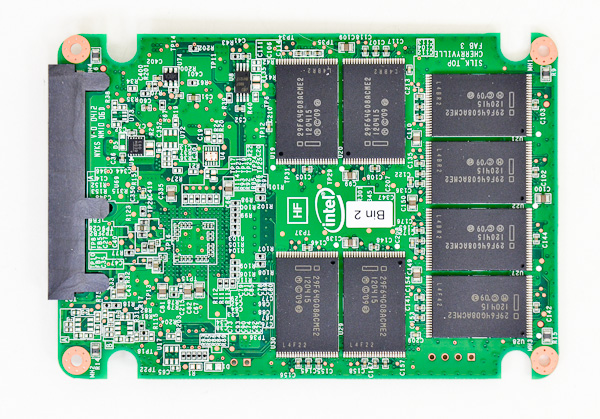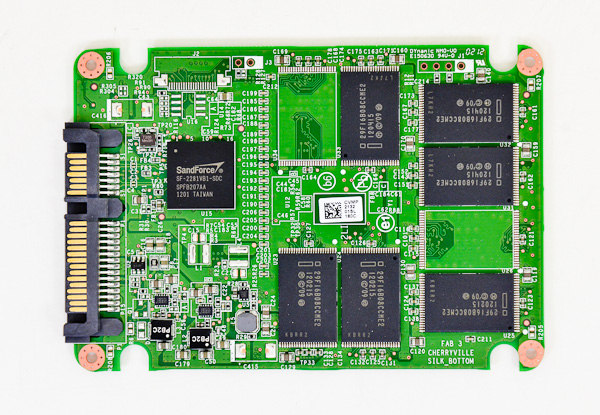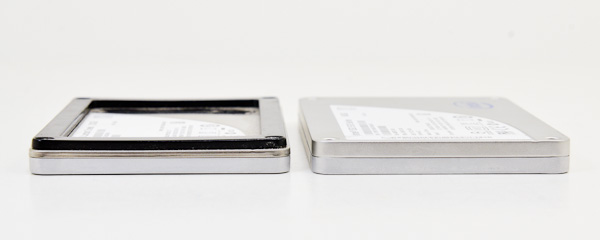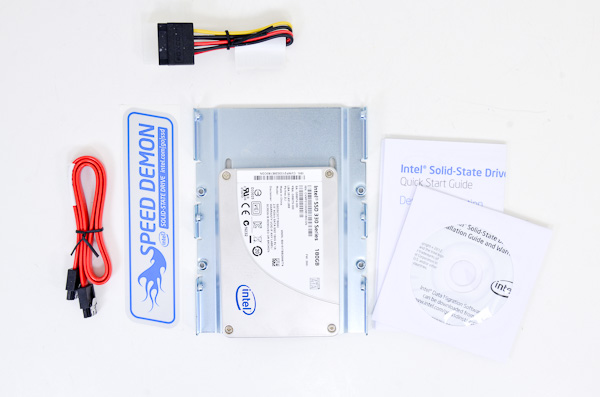The Intel SSD 330 Review (60GB, 120GB, 180GB)
by Anand Lal Shimpi on August 1, 2012 12:01 AM ESTThe Drives and Internal Architecture
The SF-2281 controller features eight NAND channels, although it can pipeline multiple requests on each channel. The 60GB and 120GB drives both feature eight NAND packages with one 8GB die and two 8GB die per package, respectively. That works out to be 64GiB of NAND on the 60GB drive, and 128GiB of NAND on the 120GB drive. RAISE is disabled on both of these drives, all spare area is dedicated for the replacement of bad blocks as well as garbage collection/block recycling.

Intel's SSD 330 60GB, all NAND appears on one side of the PCB
The 180GB drive on the other hand uses twelve NAND packages, with two 8GB 25nm MLC die per package. The math works out to be 192GiB of NAND. SandForce's redundant NAND technology (RAISE) is enabled on the 180GB drive, so the extra spare area is divided between NAND failure coverage as well as traditional garbage collection/bad block replacement. Note the non-multiple-of-eight NAND configuration poses a bit of a challenge for extracting peak performance out of the drive, however it's still able to deliver a tangible advantage over the 120GB version. It's possible that Intel still routes all 8 channels to NAND die and simply sacrifices pipelining of requests on some of the channels.

Intel's 180GB SSD 330 features twelve NAND packages (6 on each side)
In the case of all of the Intel SSD 330 models, the SF-2281 controller is cooled by a thermal pad that helps dissipate heat across the SSD's metal chassis. All 330s are 9.5mm thick without any external removable spacer, which sets these drives apart from most Intel SSDs. Strangely enough, the plastic spacer that's normally on the outside of the drive is actually located on the inside of the 330, although it's not actually responsible for the thicker form factor. I'm not sure why, but it's in there.

Typical 9.5mm Intel SSD (left) vs. 9.5mm Intel SSD 330 (right)
The Bundle
The standard 330 bundle comes with a molex to SATA power adapter, a SATA cable, a 2.5" to 3.5" drive sled and a link to download Intel's Data Migration Software (powered by Acronis).
As the 330 isn't targeted at OEMs, I'm not sure if we'll see standalone drives sold without the bundle. As of now this is the only way to get the 330.












64 Comments
View All Comments
Lacrimosa - Saturday, September 15, 2012 - link
Hello,Good review. I had been looking for Intel 330 for my laptop. I would like to have the data encrypted though and according to this review the 330 is not a good option for me then. What are the good comparable options then? Reliability and ability to encrypt are the qualities I would be looking for and it would be nice if the price weren't too high either.
P_Turner - Monday, December 3, 2012 - link
I've just RMA'd an Intel 330 SSD 180 GB back to Newegg. I get a BSOD on each and every resume from sleep. Unfortunately, Newegg won't issue refunds for this SSD (a Cyber Monday special), although they will process an RMA if you pay for the shipping.Be sure to read the Intel SSD forum BEFORE the purchase. Lots of complaints over BSODs on the 330 and 520. Worse, the complaints are just ignored by Intel.
Just my opinion, but all Sandforce based SSDs are obsolete from the get go. It's also my opinion that a big name on the label means nothing if the company just blows off customer issues.
P_Turner - Sunday, December 30, 2012 - link
The new Intel 330 180 GB that Newegg sent me was the same as the one I RMA'd. Same BSOD issue, 100% repeatable. So the question at this point was: is my Asus x83-vb laptop incompatible with SSDs?To answer the question, I pulled my 64 GB Crucial M4 out of my desktop, where it is the OS and program disk. Of course, I imaged the M4 first. The M4 then went into my Asus x83-vb after a secure erase.
The result was that the Crucial M4 was flawless. Newegg has relented and is allowing me to return the Intel 330 for store credit in the form of an e-gift card.
I've ordered a 256 gb M4 from Newegg, and I will post the results -- good or bad -- provided that posts to this article remain open. It could be that the Asus's BIOS doesn't allow an SSD larger than 64 GB or it could be that I just got lucky with my old M4. I'll know in two weeks.
ghabhaducha - Saturday, January 5, 2013 - link
Hi Anand,Thanks for such an awesome review of drives, clearly you have a talent for journalism.
After reading the extensive information you have on SSDs at Anandtech, I decided to purchase 2x Intel 330 240GB for the purposes of RAID0. Now, the way I understood it, the 180GB model uses 12x "29f16b08ccme2" Intel 16GB 25nm NAND flash, which based on your reviews, is also used by the OCZ Vertex 3 240GB and Kingston HyperX 240GB. I was curious if the Intel 330 240GB used the same "29f16b08ccme2" flash OR does it use the "29f16b08ccme3" flash that is used in the Kingston HyperX 3k? I really didn't want pry open my SSDs and void the warranty, but I was curious if you had documented this during your reviews.
Thanks,
ghabhaducha